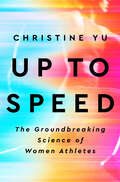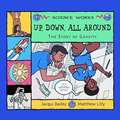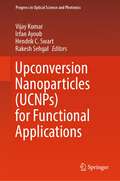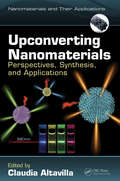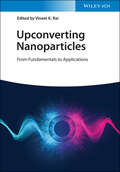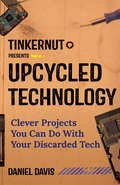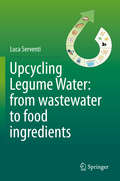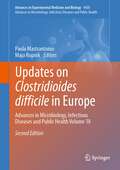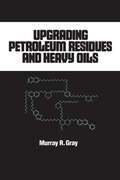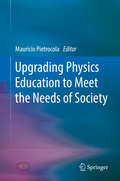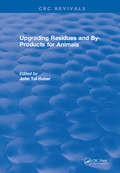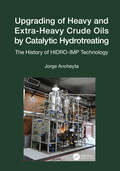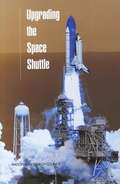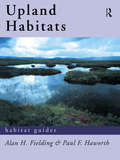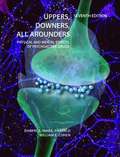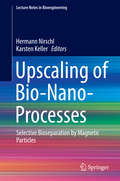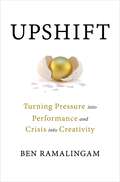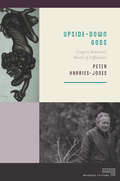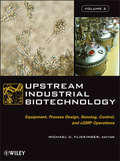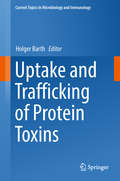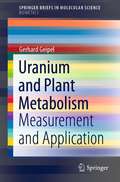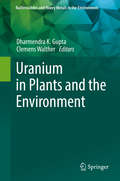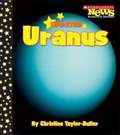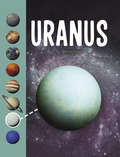- Table View
- List View
Up to Speed: The Groundbreaking Science of Women Athletes
by Christine Yu&“Up to Speed is a roadmap and toolbox for athletes of all ages. Every coach should read it and discuss it with their athletes. I wish I had been able to read this book while I was competing.&” —Kara Goucher, Olympic long-distance runner and author of The Longest RaceHow the latest science can help women achieve their athletic potential Over the last fifty years, women have made extraordinary advances in athletics. More women than ever are playing sports and staying active longer. Whether they&’re elite athletes looking for an edge or enthusiastic amateurs, women deserve a culture of sports that helps them thrive: training programs and equipment designed to work with their bodies, as well as guidelines for nutrition and injury prevention that are based in science and tailored to their lived experience.Yet too often the guidance women receive is based on research that fails to consider their experiences or their bodies. So much of what we take as gospel about exercise and sports science is based solely on studies of men. The good news is, this is finally changing. Researchers are creating more inclusive studies to close the gender data gap. They&’re examining the ways women can boost athletic performance, reduce injury, and stay healthy. Sports and health journalist Christine Yu disentangles myth and gender bias from real science, making the case for new approaches that can help women athletes excel at every stage of life, from adolescence to adulthood, through pregnancy, menopause, and beyond. She explains the latest research and celebrates the researchers, athletes, and advocates pushing back against the status quo and proposing better solutions to improve the active and athletic lives of women and girls.
Up, Down, All Around: A Story of Gravity (Science Works)
by Jacqui Bailey Matthew LillyExplains the concept of gravity by taking a trip on the space shuttle. Lexile Measure: 0700
Upconversion Nanoparticles (Progress in Optical Science and Photonics #24)
by Vijay Kumar Hendrik C. Swart Irfan Ayoub Rakesh SehgalThis book explores upconversion nanoparticles (UCNPs) at both, the fundamental as well as applied levels, for functional applications. It provides a broad perspective about the synthesis approaches of UCNPs with the preferred size, improved and tunable upconversion luminescence, along with the combined multifunctionality for various applications. It highlights the fundamentals and systematic developments in the tuning of UC emission and surface engineering of UCNPs that make UCNPs convenient for use in a large range of applications. Moreover, it gives an understanding of the imposed limitations and challenges associated with these methods to achieve the desired performance in targeted applications. It also includes the latest multifunctional lanthanide-based UCNPs, which efficiently convert low-energy photons into high-energy photons, and their applications in fluorescent microscopy, deep-tissue bioimaging, nanomedicine, optogenetics, solid-state lighting, solar cells, security labeling, and volumetric display.
Upconverting Nanomaterials: Perspectives, Synthesis, and Applications (Nanomaterials and their Applications)
by Claudia AltavillaUpconverting Nanomaterials: Perspectives, Synthesis, and Applications serves as a powerful instrument that explores cutting-edge research knowledge on the topic of upconverting nanosystems, while simultaneously providing the necessary fundamental background for nonspecialist readers. The various aspects of upconverting materials are approached both from a theoretical point of view, particularly upconverting phenomenon, and a practical one. By presenting synthetic strategies, functionalization, production of core shell structures and nanocomposites, this book supplies PhD students, researchers, and scientists with a wealth of ideas they can apply to different fields of research. Thirty-five renowned scientists from around the world have collaborated to produce 11 chapters that help to "make a voyage" through the most important aspects of UPNPs, including syntheses, mechanism, functionalization, and applications.
Upconverting Nanoparticles: From Fundamentals to Applications
by Vineet K. RaiModern learning resource providing broad coverage of the rapidly-advancing field of upconverting nanoparticles This modern reference explains photon upconversion technology using nanoparticles from first principles to novel and future applications in imaging, sensing, catalysis, energy technology, biomedicine, and many other areas. Expert authors discuss both established and novel materials and applications, going far beyond the coverage of previously published books on the subject. Key topics covered in the book include: Synthesis, characterization, and basic properties of nanoparticles with photon-upconverting properties New types of upconverting nanoparticles, including transition metal- and rare earth-doped materials, metal-organic frameworks, core/shell particles, and surface-modified particles Current and emerging application areas for upconverting nanoparticles, including heating, lighting, sensing, and detection Biomedical uses of nanoparticles, including photodynamic therapy Photon upconversion using nanoparticles has opened the door to a new universe of light-powered technology. This book is a key resource for scientists, physicists, and chemists across a wide range of disciplines who wish to master the theory, methods and applications of this powerful new technology.
Upcycled Technology: Clever Projects You Can Do With Your Discarded Tech (Tinkernut)
by Daniel T. DavisDIY science projects using old tech to create new zombie tech—an eco-friendly, fantastic way to learn about today&’s technology. We all have a drawer or closet full of old discarded tech just sitting around, gathering dust. Memories of a bygone technological era that have been replaced by newer, shiner, smarter devices. What can you do with them? Most of us don&’t even know how to properly dispose of them. If only there was a way to save them from their untimely fate. Well empty out that drawer and grab a screwdriver because the time has come to bring these old devices back from the grave! Old technology may no longer be useful, but it isn&’t useless. Hidden inside often-discarded devices is a treasure trove of motors, magnets, screens, and other parts just waiting for a chance to be upcycled! And this type of &“upcycling&” doesn&’t mean turning an old CD into a coaster, it means something a little more hardcore, like . . . · How to make a great Wi-Fi security camera with an old cell phone · How to make a basic 3D printer out of old computer disk drives · What can be made with the rare-earth magnets inside old hard drives or the reusable LCD screens in old phones · And much more Fans of Popular Science, Smithsonian&’s Maker Lab, and The Big Book of Makerspace Projects will love Upcycled Technology.
Upcycling Legume Water: from wastewater to food ingredients
by Luca ServentiFood manufacturing generates an incredibly high volume of wastewater. The legume industry is one of the top contributors to this environmental issue, as soaking and boiling are necessary to transform dried legumes into cooked canned products and other legume-based products, such as soymilk, tofu, hummus and flours. Wastewater must be treated prior to disposal into the environment, thus raising production costs for the food industry. In addition, wastewater contains nutrients that are lost from the food chain after disposal. As water and soluble nutrients are becoming a limited resource, it is critical to optimize food manufacturing at all levels. Recycling Legume Wastewater Into Food Ingredients presents a sustainable solution to this increasing demand for food and water. The text analyses the composition of legume wastewater and its physicochemical properties, including its potential applications in emulsifiers, foaming agents, gelling agents and antistaling ingredients. Early chapters discuss the processing of legumes and the wastewater generation involved. Further sections focus on wastewater generated by soaking and cooking, including the composition, functional properties, and food applications involved in each. Sprouting water, bioactives and applications in edible packaging are also discussed. In presenting a sustainable solution for legume wastewater use, this text is an important key to sustainability in food processing and the reduction of waste.
Updates on Clostridioides difficile in Europe: Advances in Microbiology, Infectious Diseases and Public Health Volume 18 (Advances in Experimental Medicine and Biology #1435)
by Paola Mastrantonio Maja RupnikThis fully updated second edition outlines the currently available clinical, epidemiological and experimental data on Clostridioides difficile infections(CDI) with special emphasis on studies and results achieved in Europe. The incidence and severity of CDI has increased significantly over the last decade, and the book explains why C. difficile, recently reclassified as Clostridioides difficile, remains a significant challenge, also from economic perspective, to health care systems all over the world. The different reservoirs of this ubiquitous microorganism are reviewed as well as the different factors contributing to its virulence, such as toxins and biofilm formation. The rapid evolution of antibiotic resistance is clearly a concern and in a specific way can influence the CDI epidemiology. Additionally, new emerging strains and comparative genomics studies are taken into consideration for their relevance from epidemiological and evolutionary point of view. The book also gives an overview on diagnostics, therapy and surveillance, all of which are still challenging. Therefore, a closer look is taken on the effect of probiotics as an alternative to antibiotics, for prevention and treatment of CDI. Fecal transplantation from healthy donors, passive immunotherapies and vaccines for patients with recurrences are also discussed in dedicated chapters. New topics included sporulation and membrane vesicles in C. difficile. The book closes with a summary of the history and the achievements of the European Society of Clinical Microbiology and Infectious Diseases Study Group for Clostridium difficile (ESGCD) written by the current and past presidents of the Society. It is the aim of this book to raise awareness on CDI and to disseminate updated information on its prevention, diagnosis and treatment.
Upgrade Your Teaching: Understanding By Design Meets Neuroscience
by Judy Willis Jay McTigheHow can educators leverage neuroscience research about how the human brain learns? How can we use this information to improve curriculum, instruction, and assessment so our students achieve deep learning and understanding in all subject areas? Upgrade Your Teaching: Understanding by Design Meets Neuroscience answers these questions by merging insights from neuroscience with Understanding by Design (UbD), the framework used by thousands of educators to craft units of instruction and authentic assessments that emphasize understanding rather than recall.
Upgrading Petroleum Residues and Heavy Oils
by R. Murray Gray"This useful reference offers in-depth coverage of current techniques for converting heavy oils and residues into more valuable distillates.Examines the chemistry of heavy hydrocarbon feeds and their properties important to engineering design, including phase behavior, reaction kinetics, and thermodynamic and transport characteristics!"
Upgrading Physics Education to Meet the Needs of Society
by Maurício PietrocolaNations around the globe consider physics education an important tool of economic and social development and currently advocate the use of innovative strategies to prepare students for knowledge and skills acquisition. Particularly in the last decade, a series of revisions were made to physics curricula in an attempt to cope with the changing needs and expectations of society. Educational transformation is a major challenge due to educational systems’ resistance to change. Updated curriculum content, pedagogical facilities (for example, computers in a school), new teaching and learning strategies and the prejudice against girls in physics classes are all issues that have to be addressed. Educational research provides a way to build schemas and resources to promote changes in physics education. This volume presents physics teaching and learning research connected with the main educational scenarios.
Upgrading Residues and By-products for Animals
by J. Tal HuberAccumulation into one source of what is known regarding the feeding value of these materials and systems which have been developed for improving their digestibility, palatability or methods of handling was the motivation for organising this book. These has been an effort to include the major categories of unconventional materials which can potentially be upgraded to provide the ruminant with needed nutrients, but certainly some have been missed. It is hoped that this treatise will prove to be a valuable tool for workers involved in improving the utilization of residues and waste products for animals.
Upgrading of Heavy and Extra-Heavy Crude Oils by Catalytic Hydrotreating: The History of HIDRO-IMP Technology
by Jorge AncheytaThis book explores the common approaches to upgrade heavy and extra-heavy crude oils by means of catalytic hydrotreating, emphasizing hydrogen addition technology as well as carbon rejection alternatives. Kinetic and reactor models are combined with experimental data to simulate and optimize commercial-scale reactor performance. Key Features• Focuses on fixed-bed catalytic hydrotreating and catalysts and process scheme characteristics for commercial application.• Guides readers on hydrotreating process technology development from batch reactor experiments to semi-commercial test.• Describes step-by-step methodologies for development of kinetic models based on experimental data generated at different reaction scales.• Provides detailed explanation on how to formulate a reactor model for the simulation of catalytic hydrotreating of heavy oils. A comprehensive guide to the upgrading of crude oils, this book has particular appeal for petroleum refining industry professionals, catalyst developers, workshop instructors, professors, and their graduate and postgraduate students.
Upgrading the Space Shuttle
by Committee on Space Shuttle UpgradesThe National Academies Press (NAP)--publisher for the National Academies--publishes more than 200 books a year offering the most authoritative views, definitive information, and groundbreaking recommendations on a wide range of topics in science, engineering, and health. Our books are unique in that they are authored by the nation's leading experts in every scientific field.
Upland Habitats (Habitat Guides)
by Alan F. Fielding Paul F. HaworthUpland Habitats presents a comprehensive illustrated guide to the habits wildlife and conservation of Britains last wilderness areas. These include: heather moors, sheep walk deer forest, blanket bogs, montane and sub-montane forests. The book examines the unique characteristics of uplands and the ecological processes and historical events that have shaped them since the end of the last glaciaton. Among the key conservation and management issues explored in are:* modern agricultural practices and economics* habitat degradation through overgrazing* commercial forest plantations* the persecution of wildlife* recreation in the uplands* the funding of upland farming.
Uppers, Downers, All Arounders: Physical and Mental Effects of Psychoactive Drugs
by Cns Productions IncOver 400 colleges and universities have adopted this up-to-date user-friendly textbook addressing psychoactive drugs and compulsive behaviors. Wide-ranging research and extensive citations make this an excellent reference source. A companion Study Guide containing chapter outline, guided review, practice tests, a drug identification table, and an extended glossary is available to download with each copy. Key ideas and concepts are highlighted throughout the book. This technique along with the Study Guide aids readers in processing the materials. Instructor support materials are also available. The content relies on the most current data and studies as well as practical information and interviews drawn from treatment professionals and their clients. The material gives perceptive insights into the complex fields of drug abuse, compulsive behaviors, addiction, treatment, recovery, and prevention. QR (quick response) codes access short videos for each chapter, and hundreds of illustrations, photos, and graphics make this clearly, concisely, and simply written textbook valuable to instructors, students, and professionals alike.
Upscaling of Bio-Nano-Processes
by Hermann Nirschl Karsten KellerDespite ongoing progress in nano- and biomaterial sciences, large scale bioprocessing of nanoparticles remains a great challenge, especially because of the difficulties in removing unwanted elements during processing in food, pharmaceutical and feed industry at production level. This book presents magnetic nanoparticles and a novel technology for the upscaling of protein separation. The results come from the EU Project "MagPro2Life", which was conducted in cooperation of several european institutions and companies.
Upshift: Turning Pressure into Performance and Crisis into Creativity
by Ben RamalingamWith over two decades’ experience both observing and interpreting how people channel disaster into opportunity in the most extreme circumstances and environments on Earth, Ben Ramalingam has a unique vantage point from which to identify the key principles that can enable anyone to use stress as an opportunity for change.In Upshift, Ramalingam distils this expertise into an insightful, powerful, and engaging book that will show you how to reframe your set responses to stress and pressure and instead use them to harness the potential they hold not just for improving your work, your relationships, and your mindset, but for transforming them.Upshift takes readers on an epic journey from early humans’ survival of the Ice Age to present times in our inescapable, pernicious and ever-shifting digital landscape. You will hear remarkable stories from a vast range of upshifters—all of whom carved new routes around perceived barriers using their powers to upshift. Underlying stories of how city commuters navigate train cancellations to how astronauts deal with life-threatening incidents, is one key message: We all have the power to innovate, whether or not we identify ourselves as creative or extraordinary.Maybe you’re the challenger, who thrives by constructively disrupting the status quo like Greta Thunberg. Or perhaps you find yourself constantly tweaking, prodding, breaking, rebuilding, and improving like crafters such as the team that revolutionized space travel called the NASA Pirates. Do you love introducing people whose combined efforts will lead to greater achievements? You might be a connector, like master networker Ariana Huffington.In a runaway world that is an engine for perpetual crisis, Upshift is not only an essential toolkit for survival, it is a roadmap for positive, and potentially life-changing transformation and influence. You don’t have to shut down – you can upshift.
Upside-Down Gods: Gregory Bateson's World of Difference (Meaning Systems)
by Peter Harries-JonesThis intellectual biography covers the trajectory of Bateson’s career, from his anthropological work in Bali alongside his wife, Margaret Mead, to his contributions to family therapy in the United States, and to studies of recursion as a feature of communication patterns in both the human and in the animal world. Layers of feedback with their many differing contexts, highlight the presence of meaning in social relations in contrast to that absence of meaning, purposefully proposed, within information theory. Throughout the human and in the animal world, recursion of feedback accounts for grasp of patterns, their difference, and with ability to communicate, enable transduction of perceptions of difference.Bateson’s insistence on feedback and communication re-frames many aspects of culture, psychology, biology, and evolution. His legacy is recognized as an important precursor to the formation of a new science called Biosemiotics.Harries-Jones argues that Bateson turns conventional causality upside down through showing how humanity’s perceptions, as with perceptions of all sentient beings, are anticipative. All sentient beings abduct from recursive patterns, rather than relying on linear evidence gathered about time/space movements of objects. Thus circular pattering provides clearer perceptions of the difference between sustainable creativity and current biocide, between our appreciation of nature’s aesthetics and time/space ‘games of power’ which underlie so many social and biological theories.
Upstream Industrial Biotechnology, 2 Volume Set
by Michael C. FlickingerBiotechnology represents a major area of research focus, and many universities are developing academic programs in the field. This guide to biomanufacturing contains carefully selected articles from Wiley's Encyclopedia of Industrial Biotechnology, Bioprocess, Bioseparation, and Cell Technology as well as new articles (80 in all,) and features the same breadth and quality of coverage and clarity of presentation found in the original. For instructors, advanced students, and those involved in regulatory compliance, this two-volume desk reference offers an accessible and comprehensive resource.
Uptake and Trafficking of Protein Toxins
by Holger BarthThis volume focuses on the transport of medically relevant bacterial protein toxins into mammalian cells, and on novel pharmacological strategies to inhibit toxin uptake. The first chapters review our current understanding of the cell-surface receptors and cellular transport processes of Clostridium botulinum neurotoxins, Clostridium botulinum C3 toxin, Clostridium difficile toxins, binary clostridial enterotoxins, anthrax toxins and diphtheria toxin. In brief, specific binding/transport (B) subunits deliver the enzyme (A) subunits into the cytosol, where the latter modify their substrates, producing cytotoxic effects and the characteristic toxin-associated diseases. Key mechanisms for the transport of the A subunits from endosomes into the cytosol and the role of trans-membrane pores formed by the B subunits and host cell chaperones for this process are reviewed. The book's closing chapters focus on compounds which inhibit the transport of the A subunits from endosomes into the cytosol and therefore might lead to novel therapeutic strategies for toxin-associated diseases. These substances include pharmacological inhibitors of the host cell chaperones involved, as well as multivalent and heterocyclic molecules that specifically block the toxins' translocation channels. This volume offers an up-to-date resource for scientists.
Uranium and Plant Metabolism: Measurement and Application (SpringerBriefs in Molecular Science)
by Gerhard GeipelThis book explores the uranium uptake by plants and its impact on plant physiology and biochemistry. In the first part of this work, the author summarizes the chemistry of uranium, its use and its environmental distribution. Then, particular attention is given to the methods for uranium detection, and to the plant biochemical reactions that influence the uranium uptake. Readers will also discover several strategies adopted by cells to immobilize and handle uranium.
Uranium in Plants and the Environment (Radionuclides and Heavy Metals in the Environment)
by Dharmendra K. Gupta Clemens WaltherIn recent years, radioactive contamination in the environment by uranium (U) and its daughters has caused increasing concerns globally. This book provides recent developments and comprehensive knowledge to the researchers and academicians who are working on uranium contaminated areas worldwide. This book covers topics ranging from the beginning of the nuclear age until today, including historical views and epidemiological studies. Modelling practices and evaluation of radiological and chemical impact of uranium on man and the environment are included. Also covered are analytical methods used for the determination of uranium in geo/bio environments. Some chapters explore factors which influence uranium speciation and in consequence plant uptake/translocation. Last but not least, several chapters provide approaches and practices for remediation of uranium contaminated areas.
Uranus
by Christine Taylor-ButlerFeatures: - Includes vocabulary word hunt with pronunciations, glossary, and index - Labeled diagrams and timelines - Beautiful, full-color photographs - Simple interior design and easy-to-read fonts - Web sites for further research and information - Vocabulary preview and review pages plus backmatter pages that invite readers to think further on the study topics - Fits science curriculum standards for earth & space science and science and technology What's New: - Updated illustrations and photos - Updated art of solar system shows 8 planets and their orbits instead of 9 - New Pluto book includes a list of other dwarf planets, in addition to Pluto, in our solar system - Updated information on space missions, moons, and planets - Updated Web sites for further information in backmatter - Updated indexes
Uranus (Planets in Our Solar System)
by Steve FoxeUranus is the seventh planet from the sun and has a special feature, it tilts! Discover the mysteries of this ice giant that sits half in darkness for more than 40 years at a time!
